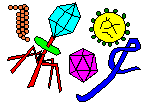| Characteristics | Viral Family | Shape | Diseases |
| DNA Viruses |
| Single strand,no envelope | Parvovirus |  | Stomach problems, fetal death |
| Double strand, no envelope | Adenovirus |  | Respiratory infections, animal tumors |
| " " | Papillomavirus |  | Warts, some cancers |
| Double strand, envelope | Orthopoxvirus |  | Smallpox, cowpox, etc. |
| " " | Herpesvirus |  | Herpes, Chickenpox, Smallpox, chickenpox, fever blisters, mononucleosis, etc. |
| " " | Hepadnavirus |  | Hepatitis B, liver tumors |
| Complex | Bacteriophages |  | These invade bacteria cells |
| RNA Viruses |
| Single strand, no envelope + strand | Picornavirus |  | Polio, hundreds of cold (rhino) viruses |
| Single strand, envelope + strand | Togavirus |  | Rubella, several encephalitises |
| " " | Flavivirus |  | Yellow fever, several encephalitises, Hepatitis C |
| " " | Coronavirus |  | Respiratory tract infections, some colds |
| - strand, single strand | Rhabdovirus |  | Rabies and numerous animal diseases |
| " " | Filovirus |  | Ebola and Marburg |
| " " | Paramyxovirus |  | Mumps, parainfluenza, other diseases |
| - strand, multiple strands | Orthomyxovirus |  | Red blood cell problems |
| " " | Bunyavirus |  | Hantaviruses and some influenzas |
| " " | Arenavirus |  | hemmorhagic fevers, lymphocytic choriomeningitis |
| DNA producer | Retrovirus |  | HIV, leukemia, some tumors |
| Double-stranded RNA, no envelope | Reovirus |  | Colorado tick fever, mild respiratory infections, others |



















 Viruses are not alive. Actually, viruses have some characteristics of living things, but not all of them. Viruses are also incapable of carrying on these proceses without the help of living cells. They're dependant upon cells to reproduce. Because they do reproduce, they have nucleic acids and effect living organisms so much, they are studied with the world of life, but again, they're not really alive. Well, most of the time.
Viruses are not alive. Actually, viruses have some characteristics of living things, but not all of them. Viruses are also incapable of carrying on these proceses without the help of living cells. They're dependant upon cells to reproduce. Because they do reproduce, they have nucleic acids and effect living organisms so much, they are studied with the world of life, but again, they're not really alive. Well, most of the time. Viruses are little more than some DNA or RNA wadded up in a little container.
Once inside a cell, the DNA or RNA uncoils and worms its way into the genetic code of the cell. This added nucleic acid gives instruction to the cell to make more viruses. Here's a comparison for you. Imagine a child going with a parent to the grocery store. Let's say the child writes a few items down on the shopping list, and the parent doesn't notice and buys them anyway. A similar thing is happening. The cell follows the directions handed to it and in turn makes more viruses. In this way, the virus can use the cell to make more little viruses.
Viruses are little more than some DNA or RNA wadded up in a little container.
Once inside a cell, the DNA or RNA uncoils and worms its way into the genetic code of the cell. This added nucleic acid gives instruction to the cell to make more viruses. Here's a comparison for you. Imagine a child going with a parent to the grocery store. Let's say the child writes a few items down on the shopping list, and the parent doesn't notice and buys them anyway. A similar thing is happening. The cell follows the directions handed to it and in turn makes more viruses. In this way, the virus can use the cell to make more little viruses.

















